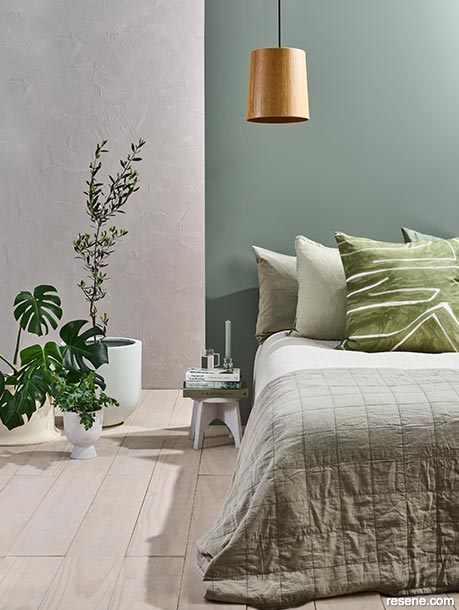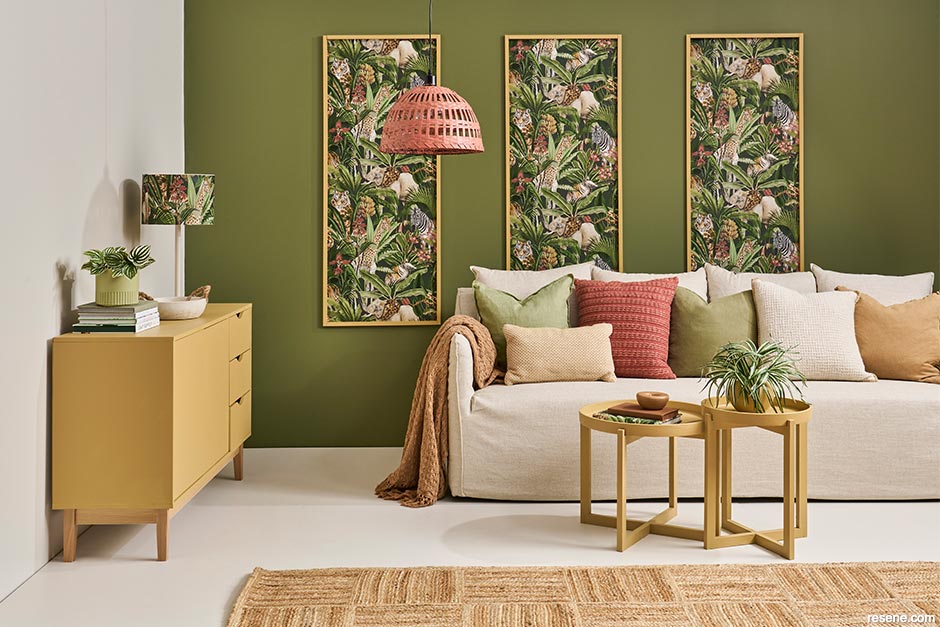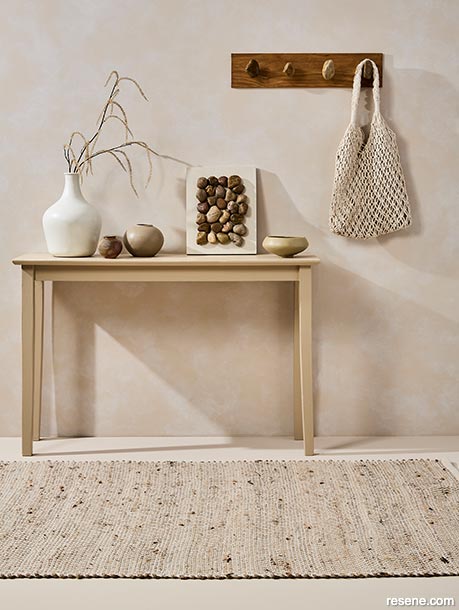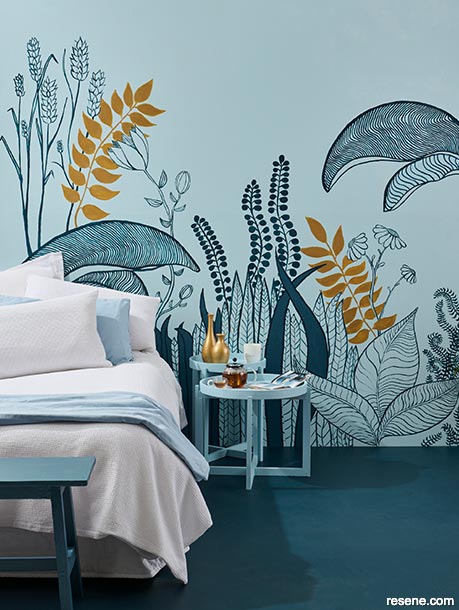From the Resene decorating blog
Connecting the indoors with the outdoors has become one of our most desired design trends.

The cloudy grey-green of Resene Ravine on the front wall of this bedroom makes it immediately soothing.
The connection to nature is emphasised with the floor finished in Resene Colorwood Whitewash and the use of plenty of plants. The rear textured wall and bedside stool are coated in Resene Sandtex Mediterranean effect tinted to Resene Concrete, the large planter is Resene Half Tasman and the vase is Resene Ravine. Cushions from Warwick Fabrics, lampshade from Citta, rug from The Ivy House. Project by Kate Alexander, image by Bryce Carleton.
It might be a seamless flow from a living room through French doors to a sweeping deck, or it might simply be connecting to the natural landscape through colour to create spaces that are soothing and comforting.
Spending time in nature has been proven to give all of us a mood lift when we need it, but it’s not always easy if you live in an intensive urban environment. Adding Resene colours inspired by nature to our interiors can be one way to find a little bit of that serenity until you’re next able to run barefoot through the grass, or take a long walk in the bush.
Neutrals are a good place to start on a colour palette that connects your room with nature and the outdoors. Resene Colour Consultant Jill Marsh suggests looking at warm whites, or even soft subtle greens and warm earthy browns, like Resene Open Sesame, which is a soft milky latte colour perfect for layering with sandy-toned Resene Tua.
“Resene Rice Cake is a stunning light warm white, or you could try Resene Peace, which is a soft green that can feel fresh or tranquil,” she says.
Try warm white Resene Rice Cake paired with the fresh herbal green of Resene Caper. Warm whites are some of the most popular shades among Resene customers, loved for their versatility and their ability to change in different lights and against other shades.
Try the blackened finish of Resene White Pointer to anchor bolder colours like Resene Raspberry, or the chameleon-like sandy beige of Resene Half Fossil with the deep primordial green of Resene West Coast.
When we think of using colour to connect our interiors with the natural environment, the tendency can be to go for greens. With good reason. Green is a widely appealing colour that comes in a huge spectrum of shades. Try the colours of a rainforest canopy in Resene Permanent Green or Resene Rolling Hills, the pale leafy green of Resene Transcend or the lush lawn of Resene Green Pea.
Greens work very well with a variety of different whites and neutrals, and when they are paired with bare or washed timber, create a simple, fresh Scandi-inspired space. But interiors don’t need to stay neutral to connect you to the natural environment.
Think of the way bright flowers or fruit set off the greens and browns of your garden. Think about the evolving spectrum of colours in a sunrise or sunset on a clear night and think about the constantly changing blues of the sea or sky.

If you want a colour scheme that connects you to nature that you will find uplifting, inspiring or calming, think about the natural environments that most stimulate those feelings for you and try to recreate them through your colour palette.
For rose garden or other floral prettiness, try soft pinks like Resene Valentine or classic red Resene Rudolph. Try the classic Kiwi red Resene Pohutukawa against pale grey-green Resene Eau De Nil, or opt for deep fruity red with Resene Red Berry.
If you want to try tonal layers in your interiors sunset – or sunrise – shades are beautiful ones to play with. Keep to different colour intensities of dusky-hued pink or apricot shades like Resene Soiree and Resene Dawn Glow with paler Resene Dust Storm and Resene Umber White. If you want to get more of a light to dark representation of a sunset add in notes of sky blue Resene Dream Big and even purple-toned Resene Epic.
If you want to recreate a relaxing beachy landscape, pair a sandy neutral like Resene Half Tea, with parched tussock greens like Resene Field Day and the wild blue of Resene Deep Teal.
The other aspect to consider to really bring your nature-focused interior to life is to think about textures and finishes, says Jill Marsh.
She suggests bringing in natural textures, plants, and flowers, as well as natural-looking flooring, or even wooden ply on the walls will give your room a relaxed cabin or bach feel. Protect the wood and show it off with a Resene Aquaclear waterborne urethane varnish coating, or go for a washed weathered effect with Resene Colorwood Whitewash.
Rattan, cane and even stone all add visual interest and extra dimension to your room while keeping it connected to the natural, exterior environment, she says.
Eye-catching art and lots of natural light are other ways to seamlessly and subtly build that sense of symbiosis between inside and out. “Hang a beautiful landscape or a nautical painting and increase the amount of natural light to open up darker spaces.”

A textured finish to this neutral hallway not only adds visual interest, but gives the walls an organic, naturally weathered finish.
The wall is painted in Resene Biscotti with Resene FX Paint Effects Medium using Resene Quarter Thorndon Cream. Floor painted in Resene Biscotti, console table in Resene Quarter Doeskin, large vase in Resene Thorndon Cream, round vases in Resene Cement, small bowl in Resene Colins Wicket and coat rack in Resene Colorwood Ironbark. The background of the stone artwork is finished in Resene Colorwood Whitewash and the stones are coated with Resene Aquaclear waterborne clear varnish. Project by Vanessa Nouwens, image by Bryce Carleton.

Connecting to nature doesn’t mean keeping to a strictly neutral palette. This mix of blues in a nature-inspired artwork has all the serenity of being underwater or sitting in a field on a summer’s day.
The wall is painted in Resene Half Escape with the plant line drawings painted in Resene Tangaroa filled in with Resene Cello. The gold leaves and vases are painted in Resene Apache with Resene Gold Dust, the floor is Resene Tangaroa, the bedside table is Resene Escape and the end table is Resene Cello. Project by Megan Harrison-Turner, image by Bryce Carleton.
A natural place to implement your natural colour palette would be a living area that opens out to the world, via a deck or balcony, but there’s really no restrictions on what spaces work best for a nature-inspired colour scheme.
If you want to start small, try a transition space like a porch or foyer, where you can literally connect the indoors with outside. If you have opted for a pale neutral like classic Resene Alabaster as your main interior colour, graduate to subtly warmer shades in the foyer or porch. Resene Double Alabaster works well with earthy beige Resene Bison Hide and weathered sky blue Resene Emerge for a serene nature-inspired combination that will welcome guests through the door. For added drama add a berry red door in Resene Fahrenheit.
Soothing natural shades also work well in any space where you want to promote calmness and serenity, like a study or even a bathroom.
Create all the calm of a tropical spa in your bathroom with the colours of bamboo in Resene Green Days, Resene Smashed Avocado and Resene Creme De La Creme. Create a warm, desert-hued, inviting office space with walls in Resene Tuscany, Resene Solitaire and deep sky-blue Resene Rulebreaker.
The key to creating a successful and appealing colour palette that connects your interiors to the outdoors will come down to finding the shades that really speak to you and invoke for you the same feelings of calm and inspiration you find in nature.







November 28, 2022
For help choosing colours to suit your projects, visit your local Resene ColorShop, ask a Resene Colour Expert online or book a Resene Colour Consultation.
Book a colour consult | Ask a Colour Expert | Ask a Paint Expert
Resene's decorating blog
Paint your home beautiful! Discover the latest decorating trends, tips and colour news.
![]()
Previous «
The new minimalism
![]()
Blog home
View the latest trends, tips and news
![]()
» Next
Common home reno problems and how to fix them